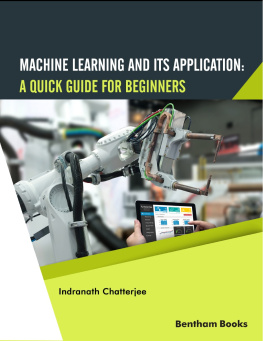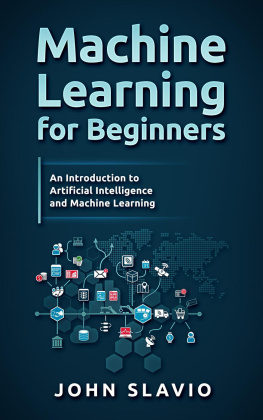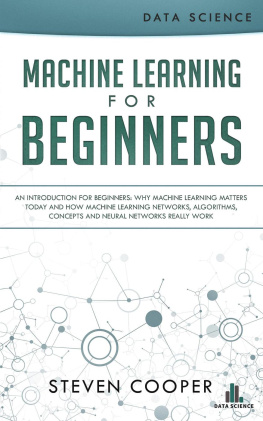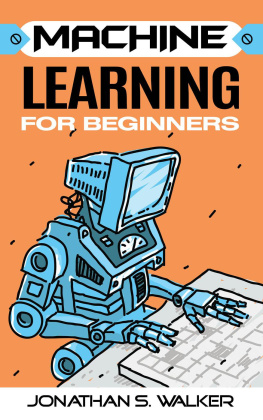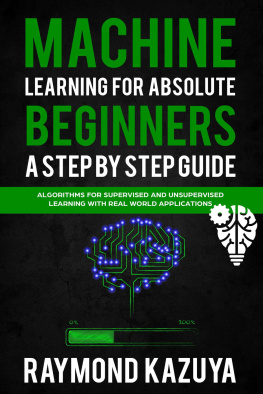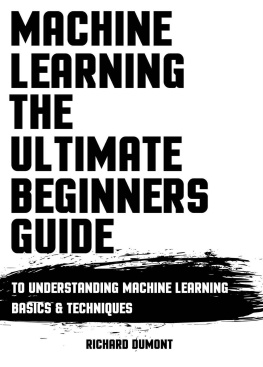Indranath Chatterjee - Machine Learning and Its Application: A Quick Guide for Beginners
Here you can read online Indranath Chatterjee - Machine Learning and Its Application: A Quick Guide for Beginners full text of the book (entire story) in english for free. Download pdf and epub, get meaning, cover and reviews about this ebook. year: 2022, publisher: Bentham Science Publishers Ltd., genre: Children. Description of the work, (preface) as well as reviews are available. Best literature library LitArk.com created for fans of good reading and offers a wide selection of genres:
Romance novel
Science fiction
Adventure
Detective
Science
History
Home and family
Prose
Art
Politics
Computer
Non-fiction
Religion
Business
Children
Humor
Choose a favorite category and find really read worthwhile books. Enjoy immersion in the world of imagination, feel the emotions of the characters or learn something new for yourself, make an fascinating discovery.
- Book:Machine Learning and Its Application: A Quick Guide for Beginners
- Author:
- Publisher:Bentham Science Publishers Ltd.
- Genre:
- Year:2022
- Rating:4 / 5
- Favourites:Add to favourites
- Your mark:
- 80
- 1
- 2
- 3
- 4
- 5
Machine Learning and Its Application: A Quick Guide for Beginners: summary, description and annotation
We offer to read an annotation, description, summary or preface (depends on what the author of the book "Machine Learning and Its Application: A Quick Guide for Beginners" wrote himself). If you haven't found the necessary information about the book — write in the comments, we will try to find it.
Machine Learning and Its Application: A Quick Guide for Beginners — read online for free the complete book (whole text) full work
Below is the text of the book, divided by pages. System saving the place of the last page read, allows you to conveniently read the book "Machine Learning and Its Application: A Quick Guide for Beginners" online for free, without having to search again every time where you left off. Put a bookmark, and you can go to the page where you finished reading at any time.
Font size:
Interval:
Bookmark:
Indranath Chatterjee
The introduction chapter summarizes various necessary topics on artificial intelligence and machine learning. It introduces the readers with a strong foundation on the basic concepts of advanced usage of artificial intelligence, which led to the beginning of an era of machine learning. Here, the readers will learn different aspects of machine learning concisely which are described in detail in the coming chapters. Firstly, this chapter discusses the dimensions of AI and the reasons for the transition of traditional AI to modern-day machine learning techniques. Secondly, it discusses the benefits of machine learning in day-to-day life. Thirdly, it discusses the machine learning algorithms' main pillars for training and developing prediction models. Finally, this chapter will give a broad outline of this book in a concise chapter-wise description.
Artificial intelligence or AI refers to the simulation of human intelligence of computers designed to think and imitate their behavior like humans. The word can also be extended to any system that shows features linked to a human mind, such as understanding and problem-solving.
When most people use the word artificial intelligence, robots are usually the first to come to mind. In this way, big-budget films and novels have created a story about a robot that destroys earth and humans. However, it is not far from the facts.
Authors Stuart Russell and Peter Norvig discuss the topic in their pioneering textbook Artificial Intelligence: A Modern Approach [1] by unifying their work around the theme of intelligent agents in computers. The authors described AI as:
the study of agents that receive percepts from the environment and perform actions (Russel and Norvig viii) [1].
Artificial intelligence originated from the idea that it is possible to describe human intelligence so that a computer can effectively imitate it and perform tasks, from the easiest to those that are much more complicated. Artificial intelligence's purposes include knowledge, logic, and understanding.
Previous standards that described artificial intelligence became obsolete as technology progresses. Machines that measure fundamental functions or identify text through optical character recognition, for example, are no longer thought to embody AI since this function is now taken for granted as an innate machine function.
To support several varied sectors, AI is constantly developing. AI is everywhere using a cross-disciplinary approach focused on math, computer science, linguistics, psychology, and more.
Artificial intelligence's perfect feature is the capacity to rationalize and perform decisions with the most excellent chance of fulfilling a particular purpose. Machine learning refers to the impression that computer programs can automatically learn from and respond to new data without human help. It is a branch of artificial intelligence. Deep learning techniques make this automated learning by ingesting vast quantities of unstructured data such as text, images, or video.
Artificial intelligence is certainly not another idea; its narrating roots go as far back as Greek relics. Notwithstanding, it was not precisely a century before the mechanical upset took off, and AI went from fiction to truly conceivable reality.
In the initial portion of the twentieth century, sci-fi acquainted the world with the idea of robots. By the 1950s, we had an age of researchers, mathematicians, and scholars who were socially acclimatized in their brains with the idea of human-made consciousness (or artificial intelligence). One such individual was Alan Turing, a British scientist who investigated the numerical chance of human-made consciousness. Turing recommended that people utilize accessible data to take care of issues and decide why the machines cannot do something very similar? This was the consistent system of his 1950 paper, Computing Machinery and Intelligence, in which he examined how to assemble intelligent machines and test their knowledge.
From 1957 to 1974, AI got importance. Personal computers could store more data and turned out to be fast, less expensive, and more available. AI calculations additionally improved, and individuals improved at knowing which calculation to apply to their concerns. Early exhibits, for example, Newell and Simon's General Problem Solver and Joseph Weizenbaum's ELIZA, showed promising results toward the objectives of critical thinking and the translation of communication in language individually. These victories, just as the promotion of driving specialists (particularly the participants of the DSRPAI) persuaded government offices, for example, the Defense Advanced Research Projects Agency (DARPA), to subsidize AI research few organizations. The public authority was especially inspired by a machine that could interpret and decipher communication in language just as high throughput information handling. Idealism was high, and assumptions were considerably higher. In 1970 Marvin Minsky revealed to Life Magazine, from three to eight years we will have a machine with the general intelligence of an average human being. However, while the essential rule verification was there, there was far to go before the ultimate objectives of standard language preparation, conceptual reasoning, and self-acknowledgment could be accomplished.
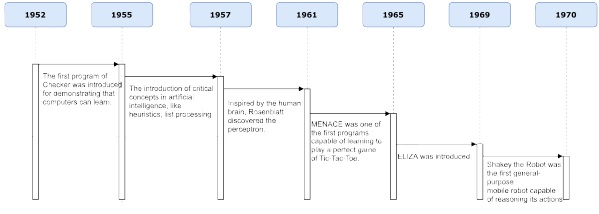
Evolution of AI from 1950's to 1970's.
As we see in Fig. (), it shows the evolution of artificial intelligence from the year 1952 to 1970.
The great scientist Simon and Minsky stated AI as:
Herbert Simon stated in 1957 that It is not my aim to surprise or shock you, but the simplest way I can summarize is to say that there are now in the world machines that think, that learn, and that create. Moreover, their ability to do these things is going to increase rapidly until in a visible future the range of problems they can handle will be coextensive with the range to which the mind has been applied.
Marvin Minsky stated in 1970 that In three to eight years, we will get a machine with average human intelligence.
During the 1980s, the AI outlook changed to emblematic AI and the supposed expert system or information-based frameworks. The fundamental thought was to get human master information in a PC structure and spread it as a program to numerous computers.
During the 1990s, organizations began delivering expert systems frameworks. These organizations offered programming bundles called inference engines and related information administrations to the clients. As in Fig. (), we see the evolution of artificial intelligence from 1968 to 1990.
Expert systems had two parts:
1. The information base an assortment of realities, facts, rules, and connections on a particular field;
2. The inference tool that depicted how to control and consolidate these images.
Current realities and rules had unequivocal portrayals and were modifiable. Lisp and Prolog were the principal representative programming languages.
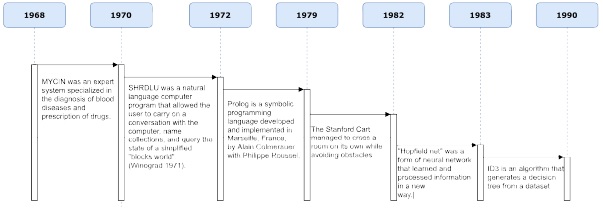
Evolution of AI from the 1970s to 1990s.
Font size:
Interval:
Bookmark:
Similar books «Machine Learning and Its Application: A Quick Guide for Beginners»
Look at similar books to Machine Learning and Its Application: A Quick Guide for Beginners. We have selected literature similar in name and meaning in the hope of providing readers with more options to find new, interesting, not yet read works.
Discussion, reviews of the book Machine Learning and Its Application: A Quick Guide for Beginners and just readers' own opinions. Leave your comments, write what you think about the work, its meaning or the main characters. Specify what exactly you liked and what you didn't like, and why you think so.

